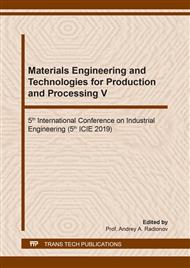[1]
W.W. Gerberich, N.I. Tymiak, J.C. Grunlan, M.F. Horstemeyer, M.I. Baskes, Interpretations of indentation size effects, Journal of Applied Mechanics, 69(4) (2002) 433-442.
DOI: 10.1115/1.1469004
Google Scholar
[2]
S.J. Bull, On the origins and mechanisms of the indentation size effect, Zeitschrift fur Metallkunde, 94(7) (2003) 787-792.
DOI: 10.3139/146.030787
Google Scholar
[3]
G.M. Pharr, J.H. Strader, W.C. Oliver, Critical issues in making small-depth mechanical property measurements by nanoindentation with continuous stiffness measurement, Journal of Materials Research, 24(3) (2009) 653-666.
DOI: 10.1557/jmr.2009.0096
Google Scholar
[4]
S. Shim, H. Bei, E.P. George, G.M. Pharr, A different type of indentation size effect, Scripta Materialia, 59(10) (2008) 1095-1098.
DOI: 10.1016/j.scriptamat.2008.07.026
Google Scholar
[5]
J.G. Swadener, E.P. George, G.M. Pharr, The correlation of the indentation size effect measured with indenters of various shapes, Journal of the Mechanics and Physics of Solids, 50(4) (2002) 681-694.
DOI: 10.1016/s0022-5096(01)00103-x
Google Scholar
[6]
A. Carpinteri, S. Puzzi, A fractal approach to indentation size effect, Engineering Fracture Mechanics, 73(15) (2006) 2110-2122.
DOI: 10.1016/j.engfracmech.2006.04.020
Google Scholar
[7]
S.A. Fedosov, L. Peshek, Determination of the mechanical properties of materials by microindentation: Modern foreign techniques, Physical Faculty of Moscow State University, Moscow, (2004).
Google Scholar
[8]
Y.I. Golovin, Nanoindentation and its capabilities, Mashinostroenie, Moscow, (2009).
Google Scholar
[9]
Y.V. Milman, А.А. Golubenko, S.N. Dub, Indentation size effect in nanohardness, Acta Materialia, 59(20) (2011) 7480-7487.
DOI: 10.1016/j.actamat.2011.08.027
Google Scholar
[10]
K. Durst, M. Goken, G.M. Pharr, Indentation size effect in spherical and pyramidal indentations, Journal of Physics D: Applied Physics, 41(7) (2008) 1-5.
DOI: 10.1088/0022-3727/41/7/074005
Google Scholar
[11]
A.K. Kampouris, A. Konstantinidis, On the interpretation of the indentation size effect (ISE) through gradient theory for Vickers and Berkovich indenters, Journal of the Mechanical Behavior of Materials, 25(5-6) (2017) 161-164.
DOI: 10.1515/jmbm-2017-0003
Google Scholar
[12]
F.R.N. Nabarro, S. Shrivastava, S.B. Luyckx, The size effect in microindentation, Philosophical Magazine, 86(25-26) (2006) 4173-4180.
DOI: 10.1080/14786430600577910
Google Scholar
[13]
V.M. Matyunin, A.Y. Marchenkov, R.Y. Agafonov, Method for determining the hardness of materials by pressing the pyramid at different scale indentation levels, Metal technology, 6 (2014) 44-47.
Google Scholar
[14]
V.M. Matyunin, A.Y. Marchenkov, R.Y. Agafonov, Method for determining the hardness of materials by pressing the pyramid at different scale indentation levels (Part 2), Metal technology, 9 (2014) 44-47.
Google Scholar
[15]
V.M. Matyunin, A.N. Demidov, M.A. Prohodtsov, B.A. Yuzikov, Influence of a scale factor on the results of determination of fertility of materials by the brinell method, Metal technology, 8 (2008) 49-51.
Google Scholar
[16]
I.J. Spary, A.J. Bushby, N.M. Jennett, On the indentation size effect in spherical indentation, Philosophical Magazine, 86(33-35) (2006) 5581-5593.
DOI: 10.1080/14786430600854988
Google Scholar
[17]
G.M. Pharr, E.G. Herbert, Y. Gao, The indentation size effect: a critical examination of experimental observations and mechanistic interpretations, Annual Review of Materials Research, 40(1) (2010) 271-292.
DOI: 10.1146/annurev-matsci-070909-104456
Google Scholar
[18]
Y. Huang, F. Zhang, K.C. Hwang, W.D. Nix, G.M. Pharr, G. Feng, A model of size effects in nano-indentation, Journal of the Mechanics and Physics of Solids, 54(8) (2006) 1668-1686.
DOI: 10.1016/j.jmps.2006.02.002
Google Scholar
[19]
A.A. Elmustafa, D.S. Stone, Nanoindentation and the indentation size effect: Kinetics of deformation and strain gradient plasticity, Journal of the Mechanics and Physics of Solids, 51(2) (2003) 357-381.
DOI: 10.1016/s0022-5096(02)00033-9
Google Scholar
[20]
A. Ruiz-Moreno, P. Hahner, Indentation size effects of ferritic/martensitic steels: A comparative experimental and modelling study, Materials and Design, 145 (2018) 168-180.
DOI: 10.1016/j.matdes.2018.02.064
Google Scholar
[21]
S.I. Gubkin, Theory of metal forming, Metallurgizdat, Moscow, (1947).
Google Scholar
[22]
A. A. Presnyakov, The center of deformation in the processing of metals by pressure, Science, Alma – Ata, (1988).
Google Scholar
[23]
V.I. Bolobov, V.S. Bochkov, S.A. Chupin, P.P. Bondarenko, T. Syuj, The dependence of the hardness of metals on the degree of plastic deformation in various methods of deformation, Factory laboratory. Diagnostics of materials, 6(81) (2015) 52-56.
Google Scholar
[24]
P.M. Ogar, D.B. Gorohov, Review of methods for determining elastoplastic deformation when introducing a sphere, Systems. Methods. Technology, 3(27) (2015) 15-22.
Google Scholar
[25]
M.V. Storozhev, Theory of metal forming, Mashinostroenie, Moscow, (1977).
Google Scholar
[26]
A.A. Bogatov, Mechanical properties and models of the destruction of metals: Textbook. Manual for high schools, UGTU-UPI, Ekaterinburg, (2002).
Google Scholar


